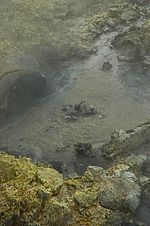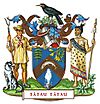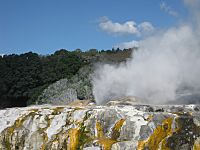Rotorua facts for kids
Quick facts for kids
Rotorua
Te Rotorua-nui-a-Kahumatamomoe (Māori)
|
||
|---|---|---|
|
|
||
|
||
| Nickname(s):
Sulphur City, Roto-Vegas
|
||
| Motto(s):
Tātau tātau
|
||
| Country | New Zealand | |
| Region | Bay of Plenty | |
| Territorial authority | Rotorua Lakes Council | |
| Settled by Māori | c. 1350 | |
| Founded | c. 1350 | |
| Borough status | 1922 | |
| City status | 1962 | |
| City status revoked | 1989 | |
| Electorate | Rotorua | |
| Area | ||
| • Territorial | 2,614.9 km2 (1,009.6 sq mi) | |
| • Urban | 46.06 km2 (17.78 sq mi) | |
| • Metro | 89.28 km2 (34.47 sq mi) | |
| Elevation | 280 m (920 ft) | |
| Population
(June 2023)
|
||
| • Territorial | 78,200 | |
| • Density | 29.906/km2 (77.45/sq mi) | |
| • Urban | 58,900 | |
| • Urban density | 1,278.8/km2 (3,312/sq mi) | |
| • Metro | 58,900 | |
| • Metro density | 659.7/km2 (1,708.7/sq mi) | |
| Demonym(s) | Rotoruan | |
| Time zone | UTC+12 (NZST) | |
| • Summer (DST) | UTC+13 (NZDT) | |
| Postcode(s) |
3010, 3015
|
|
| Area code(s) | 07 | |
| Local iwi | Ngāti Whakaue, Te Arawa | |
Rotorua is a city in the Bay of Plenty Region of New Zealand's North Island. It sits on the southern shore of Lake Rotorua, which is where it gets its name. Rotorua is known for its amazing geothermal activity and rich Māori culture. It's a popular spot for both local and international visitors.
Contents
What's in a Name?
The name Rotorua comes from the Māori language. The full name for the city and lake is Te Rotorua-nui-a-Kahumatamomoe.
- Roto means 'lake'.
- Rua means 'two' or 'second'.
So, Rotorua means 'Second lake'. This name was given by the chief Ihenga, who discovered it. It was the second big lake he found, and he named it after his uncle, Kahumatamomoe.
Rotorua is also called "Sulphur City." This is because of the hydrogen sulphide gas from the geothermal areas. It makes the city smell a bit like "rotten eggs." Another fun nickname is "Roto-Vegas." This compares the city's main street with its shops and restaurants to Las Vegas.
Rotorua's Past
Early Māori Settlement
Māori people from the Te Arawa iwi (tribe) first settled here in the 14th century. They built a busy village, called a pā, at Ohinemutu by Lake Rotorua. Local stories say that the many hot springs came from a plea by Ngātoro-i-rangi, a special ancestor. He asked the gods to send fire spirits from Hawaiki, the Māori homeland. The Te Arawa Māori living at Ohinemutu later became known as Ngāti Whakaue.
Conflicts and Early European Contact
Rotorua saw a lot of fighting during the Musket Wars in the 1820s. The powerful Ngāpuhi tribe from the north expanded south. In 1823, a group led by Ngāpuhi chiefs Hongi Hika and Pōmare I attacked Rotorua. They defeated the Te Arawa people.
The first European to visit was likely Phillip Tapsell in 1828. He was a trader. Missionaries also came in the 1830s.
Becoming a Spa Town
In the late 1800s, early European settlers were very interested in Rotorua. This was because of its unique geothermal activity. Māori and Europeans worked together to make Rotorua a famous spa town. The Ngāti Whakaue people leased land to the government for this purpose.
Rotorua became a big tourist spot because it was close to the amazing Pink and White Terraces. But these beautiful terraces were destroyed in 1886. This happened during the volcanic eruption of Mount Tarawera.
The town grew quickly after a railway line to Auckland opened in 1894. Rotorua became a borough in 1922 and a city in 1962.
Rotorua's Location and Weather
Geothermal Setting
The city of Rotorua and Lake Rotorua are inside a huge bowl-shaped area called the Rotorua Caldera. This was formed by a massive volcanic eruption about 240,000 years ago. This caldera is the reason for all the geothermal activity you see in Rotorua.
Climate and Seasons
Rotorua has a mild temperate climate. It's inland and protected by hills, so it's not as windy as some other places in New Zealand.
In winter (June to August), temperatures can drop below freezing. Frost is common, and it gets below 0 °C about 20 nights a year. Snow is very rare in Rotorua itself. It has only snowed twice in the town centre since the 1970s. However, snow does fall in the nearby Mamaku ranges more often.
| Climate data for Rotorua (1991–2020) | |||||||||||||
|---|---|---|---|---|---|---|---|---|---|---|---|---|---|
| Month | Jan | Feb | Mar | Apr | May | Jun | Jul | Aug | Sep | Oct | Nov | Dec | Year |
| Mean daily maximum °C (°F) | 22.9 (73.2) |
23.1 (73.6) |
21.1 (70.0) |
18.1 (64.6) |
15.2 (59.4) |
12.7 (54.9) |
12.0 (53.6) |
12.8 (55.0) |
14.5 (58.1) |
16.4 (61.5) |
18.6 (65.5) |
20.8 (69.4) |
17.4 (63.3) |
| Daily mean °C (°F) | 17.7 (63.9) |
18.1 (64.6) |
16.1 (61.0) |
13.4 (56.1) |
10.9 (51.6) |
8.6 (47.5) |
7.8 (46.0) |
8.4 (47.1) |
10.1 (50.2) |
11.9 (53.4) |
13.8 (56.8) |
16.2 (61.2) |
12.8 (55.0) |
| Mean daily minimum °C (°F) | 12.6 (54.7) |
13.1 (55.6) |
11.1 (52.0) |
8.7 (47.7) |
6.6 (43.9) |
4.4 (39.9) |
3.7 (38.7) |
4.1 (39.4) |
5.8 (42.4) |
7.4 (45.3) |
9.0 (48.2) |
11.5 (52.7) |
8.2 (46.8) |
| Average rainfall mm (inches) | 93.8 (3.69) |
100.4 (3.95) |
100.3 (3.95) |
133.0 (5.24) |
130.2 (5.13) |
131.9 (5.19) |
137.4 (5.41) |
125.2 (4.93) |
106.6 (4.20) |
92.9 (3.66) |
86.8 (3.42) |
117.1 (4.61) |
1,355.6 (53.38) |
| Average rainy days (≥ 1.0 mm) | 7.7 | 7.6 | 8.1 | 9.3 | 9.9 | 10.9 | 11.4 | 12.1 | 11 | 10.3 | 9.5 | 10.8 | 118.6 |
| Average relative humidity (%) | 78.8 | 81.4 | 81.5 | 83.4 | 87.1 | 87.5 | 87.3 | 85.9 | 81.6 | 79.7 | 77.2 | 78.9 | 82.5 |
| Mean monthly sunshine hours | 242.9 | 205.9 | 199.7 | 170.5 | 145.1 | 119.1 | 130.7 | 152.1 | 155.1 | 190.8 | 200.1 | 215.8 | 2,127.8 |
| Mean daily daylight hours | 14.5 | 13.5 | 12.3 | 11.1 | 10.1 | 9.6 | 9.8 | 10.7 | 11.9 | 13.1 | 14.2 | 14.8 | 12.1 |
| Percent possible sunshine | 54 | 54 | 52 | 51 | 46 | 41 | 43 | 46 | 43 | 47 | 47 | 47 | 48 |
| Source 1: NIWA Climate Data (sun and humidity 1981–2010) | |||||||||||||
| Source 2: Weather Spark | |||||||||||||
Lakes of Rotorua
The Rotorua area has 17 lakes, all together known as the Lakes of Rotorua. These lakes are great for summer activities. People enjoy fishing, waterskiing, and swimming. Many lakes are stocked with trout for sports fishing. The lakes are also used for big events. For example, Lake Rotorua hosted the World Blind Sailing Championships. Float planes also take off and land on Lake Rotorua.
City Suburbs
Rotorua has many suburbs, both close to the city centre and further out.
- Inner suburbs
- Rotorua Central
- Fenton Park
- Glenholme
- Ohinemutu
- Ōwhata
- Mangakakahi
- Western Heights
- Selwyn Heights
- Sunnybrook
- Westbrook
- Fordlands
- Springfield
- Tihi-Ōtonga
- Lynmore
- Victoria
- Pukehangi
- Kawaha Point
- Koutu
- Hillcrest
- Utuhina
- Whakarewarewa
- Ngāpuna
- Holdens Bay
- Hannahs Bay
- Fairy Springs
- Pomare
- Poets' Corner
- Kuirau
- Outer suburbs
People and Economy
Population and Diversity
The Rotorua urban area has an estimated population of about 59,000 people. It is the 13th largest urban area in New Zealand. Rotorua has the highest percentage of Māori people of any city in New Zealand. This makes it a very culturally rich place.
Rotorua's Economy
Tourism is the biggest industry in Rotorua. Many people work in hotels, cafes, and restaurants. The city is a major visitor destination.
Other important industries include high-value services like professional and technical jobs. Agriculture and forestry also play a role in the local economy.
Fun Things to Do in Rotorua
Geothermal Wonders

Rotorua is famous for its geothermal attractions. Many buildings show its history as a spa town. The Government Gardens have the Rotorua Museum of Art and History. It's in a large Tudor-style bath house. The Art Deco style Blue Baths were famous for allowing mixed-sex bathing in the 1930s. Both buildings are currently closed for safety checks.
Here are some of the geothermal places you can visit:
- Kuirau Park: Right in the city centre.
- Government Gardens: Includes Sulphur Point, known for its strong smell.
- Te Puia: A popular spot in the Whakarewarewa volcanic valley. It's home to the impressive Pōhutu Geyser.
- Tikitere: Also called Hell's Gate Geothermal Park & Mud Spa.
- Te Wairoa ("The Buried Village"): This village was covered by the 1886 Mount Tarawera eruption.
- Waimangu Volcanic Valley: A unique volcanic area.
- Waikite Valley Thermal Pools: More hot pools to enjoy.
Mountain Biking Adventures
Rotorua is a top spot for mountain biking. In 2015, it was named one of the top 6 mountain biking places in the world. The Whakarewarewa forest has over 150 km of mountain bike trails. Rotorua has also hosted big mountain bike events like the UCI Mountain Bike and Trials World Championships. Since 2015, it has hosted a round of the Crankworx World Tour every year.
Other Cool Attractions
- The Rotorua Pistol club is one of the biggest in the Southern Hemisphere.
- The Kaituna River is great for whitewater kayaking and rafting. It flows through a beautiful tree-lined gorge.
- The Wingspan National Bird of Prey Centre in Ngongotahā Valley. Here, you can see New Zealand's birds of prey. They also do falconry demonstrations.
- Rotorua is well-known for its Māori cultural tourism. You can learn a lot about Māori traditions and history.
Getting Around Rotorua
Roads and Highways
Rotorua is connected by several main roads, called state highways. These include 5, 30, and 30A. State Highway 5 is the main route connecting Rotorua to cities like Hamilton, Auckland, and Taupō.
Bus Services
Rotorua has a local bus service called Baybus. There are 11 routes that cover the city. Buses usually run every half hour. They even have bike racks on the buses! You can use a Bee Card to pay for your fares. There are also bus services that go to local tourist sites.
Air Travel
Rotorua Regional Airport is about 9 km northeast of the city. Air New Zealand offers daily flights from Rotorua to Auckland, Wellington, and Christchurch. You can also take scenic flights in helicopters and float planes from Rotorua's lakefront.
Rail Connections
Rotorua is connected to the rail network by the Rotorua Branch line. Passenger trains used to run from Auckland to Rotorua until 2001. Freight services also stopped in 2000. This was because more people and goods started using roads. The railway line is not currently used.
Learning in Rotorua
Higher Education
Rotorua is home to Toi Ohomai Institute of Technology. This is a place where you can study for certificates, diplomas, and some degrees. Popular subjects include Māori language, nursing, forestry, business, and tourism.
Secondary Schools
Rotorua has five main high schools:
- John Paul College: A co-educational (boys and girls) Catholic school for Years 7–13.
- Rotorua Boys' High School: A state school just for boys, Years 9–13.
- Rotorua Girls' High School: A state school just for girls, Years 9–13.
- Rotorua Lakes High School: For students in the eastern suburbs, Years 9–13.
- Western Heights High School: For students in the western suburbs, Years 9–13.
There is also Te Rangihakahaka Centre for Science and Technology. This school teaches in both Māori and English for Years 1–10.
Māori Language Schools
Rotorua has four Kura Kaupapa Māori. These are schools where students learn mostly in the Māori language:
- Te Wharekura o Ngāti Rongomai: Years 0–13.
- Te Kura Kaupapa Māori O Te Koutu: Years 0–13.
- Te Kura Kaupapa Māori O Ruamata: Years 0–13.
- Te Kura Kaupapa Māori O Hurungaterangi: Years 0–8.
Media in Rotorua
Rotorua has its own local media. This includes the newspaper Rotorua Daily Post and radio stations like More FM Rotorua and The Hits Rotorua.
Sister Cities
Rotorua has special connections with other cities around the world. These are called sister cities:
- Beppu, Japan
- Klamath Falls, United States
- Lake Macquarie, Australia
- Wuzhong (Suzhou), China
Famous People from Rotorua
Many well-known people come from Rotorua. Here are a few:
- Valerie Adams: Olympic shot putter.
- Steven Adams: Basketball player.
- Israel Adesanya: Mixed martial artist.
- Jean Batten: Famous aviator.
- Trent Boult: New Zealand cricketer.
- Cliff Curtis: Actor.
- Susan Devoy: Squash player.
- Alan Duff: Writer.
- Sir Howard Morrison: Entertainer.
- Temuera Morrison: Actor.
- Wayne "Buck" Shelford: Former All Black rugby player.
Images for kids
-
Beside Lake Rotorua
See also
 In Spanish: Rotorua para niños
In Spanish: Rotorua para niños

















